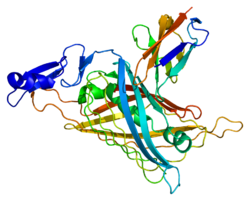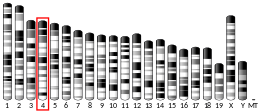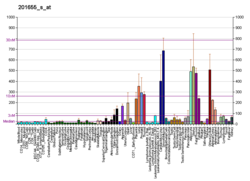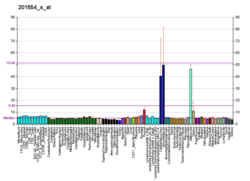
Back HSPG2 CY Perlecan German Perlecán Spanish پرلیکن FA Perlécan French Perlecano Italian HSPG2 Ukrainian
Perlecan[5] (PLC) also known as basement membrane-specific heparan sulfate proteoglycan core protein (HSPG) or heparan sulfate proteoglycan 2 (HSPG2), is a protein that in humans is encoded by the HSPG2 gene.[6][7][8][9] The HSPG2 gene codes for a 4,391 amino acid protein with a molecular weight of 468,829. It is one of the largest known proteins. The name perlecan comes from its appearance as a "string of pearls" in rotary shadowed images.
Perlecan was originally isolated from a tumor cell line and shown to be present in all native basement membranes.[10] Perlecan is a large multidomain (five domains, labeled I-V)[5] proteoglycan that binds to and cross-links many extracellular matrix (ECM) components and cell-surface molecules.[11] Perlecan is synthesized by both vascular endothelial and smooth muscle cells and deposited in the extracellular matrix of parahoxozoans.[12] Perlecan is highly conserved across species and the available data indicate that it has evolved from ancient ancestors by gene duplication and exon shuffling.[11]
- ^ a b c GRCh38: Ensembl release 89: ENSG00000142798 – Ensembl, May 2017
- ^ a b c GRCm38: Ensembl release 89: ENSMUSG00000028763 – Ensembl, May 2017
- ^ "Human PubMed Reference:". National Center for Biotechnology Information, U.S. National Library of Medicine.
- ^ "Mouse PubMed Reference:". National Center for Biotechnology Information, U.S. National Library of Medicine.
- ^ a b Noonan DM, Fulle A, Valente P, Cai S, Horigan E, Sasaki M, et al. (December 1991). "The complete sequence of perlecan, a basement membrane heparan sulfate proteoglycan, reveals extensive similarity with laminin A chain, low density lipoprotein-receptor, and the neural cell adhesion molecule". The Journal of Biological Chemistry. 266 (34): 22939–47. doi:10.1016/S0021-9258(18)54445-8. PMID 1744087.
- ^ Arikawa-Hirasawa E, Wilcox WR, Le AH, Silverman N, Govindraj P, Hassell JR, Yamada Y (April 2001). "Dyssegmental dysplasia, Silverman-Handmaker type, is caused by functional null mutations of the perlecan gene". Nature Genetics. 27 (4): 431–4. doi:10.1038/86941. PMID 11279527. S2CID 22934192.
- ^ "Entrez Gene: HSPG2 heparan sulfate proteoglycan 2".
- ^ Kallunki P, Eddy RL, Byers MG, Kestilä M, Shows TB, Tryggvason K (October 1991). "Cloning of human heparan sulfate proteoglycan core protein, assignment of the gene (HSPG2) to 1p36.1----p35 and identification of a BamHI restriction fragment length polymorphism". Genomics. 11 (2): 389–96. doi:10.1016/0888-7543(91)90147-7. PMID 1685141.
- ^ Arikawa-Hirasawa E, Le AH, Nishino I, Nonaka I, Ho NC, Francomano CA, et al. (May 2002). "Structural and functional mutations of the perlecan gene cause Schwartz-Jampel syndrome, with myotonic myopathy and chondrodysplasia". American Journal of Human Genetics. 70 (5): 1368–75. doi:10.1086/340390. PMC 447613. PMID 11941538.
- ^ Hassell JR, Robey PG, Barrach HJ, Wilczek J, Rennard SI, Martin GR (August 1980). "Isolation of a heparan sulfate-containing proteoglycan from basement membrane". Proceedings of the National Academy of Sciences of the United States of America. 77 (8): 4494–8. Bibcode:1980PNAS...77.4494H. doi:10.1073/pnas.77.8.4494. PMC 349870. PMID 6449008.
- ^ a b Iozzo RV (April 1994). "Perlecan: a gem of a proteoglycan". Matrix Biology. 14 (3): 203–8. doi:10.1016/0945-053X(94)90183-X. PMID 7921536.
- ^ Aaron L Fidler, Carl E Darris, Sergei V Chetyrkin, Vadim K Pedchenko, Sergei P Boudko, Kyle L Brown, W Gray Jerome, Julie K Hudson, Antonis Rokas, Billy G Hudson (2017) Collagen IV and basement membrane at the evolutionary dawn of metazoan tissues eLife 6:e24176 https://doi.org/10.7554/eLife.24176






